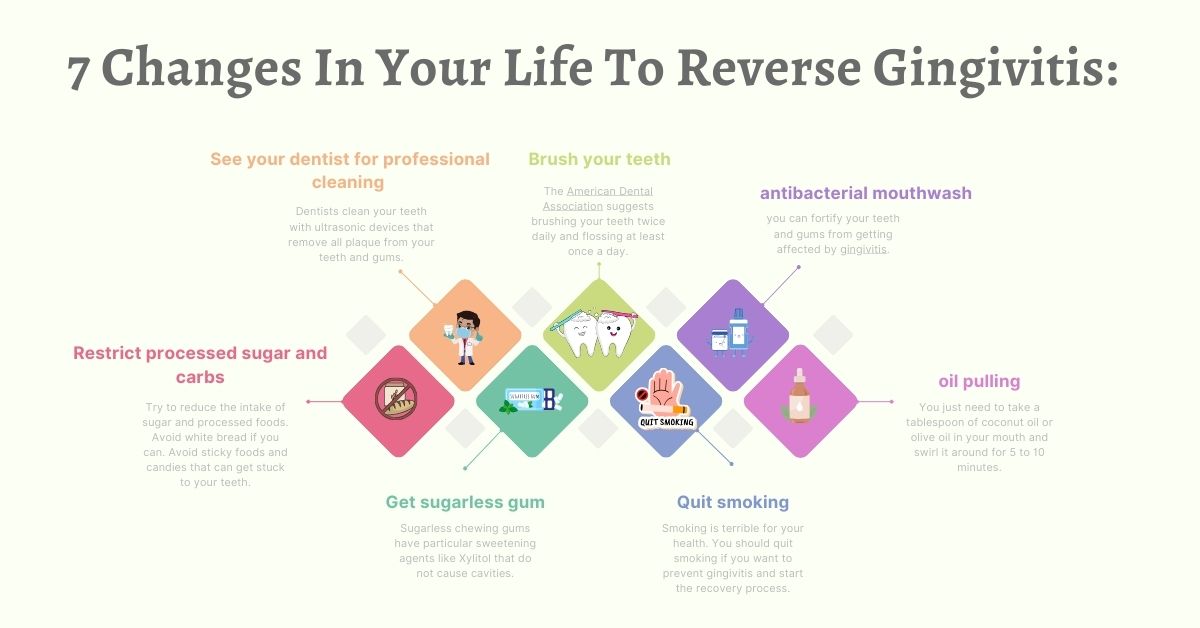October 30, 2023
One question brought you here. “Can gingivitis be reversed?”. The answer is yes.
You can reverse gingivitis by doing certain things and being more thoughtful about your oral health. You can reverse gingivitis and stop it in its tracks. If you start working on your oral health, you can successfully prevent gum disease from progressing and causing damage to your teeth and gums.
In this article, you will find out how to reverse gingivitis. You will find proven tips to prevent gingivitis and prevent it from getting worse.
The first stage of gum disease is also called gingivitis. It can be reversed with timely treatment and care. You can restore your dental health if you follow certain things and make them a part of your oral care routine. You can also develop habits like eating healthy food and avoiding smoking. Restricting sugary and acidic foods and drinks can also improve your oral health.
Gingivitis can make your gums hurt and swell up. Red, swollen, and sensitive gums are signs of trouble. Bad breath is also a sign of gingivitis. All of these symptoms are things that no one wants to experience. This is why you should know how to reverse gingivitis.
Here Are 7 Things You Can Do To Reverse Gingivitis
1. See your dentist for professional cleaning
If you want to make gingivitis go away, you need to make some time for professional dental cleaning. Dentists clean your teeth with ultrasonic devices that remove all plaque from your teeth and gums. If you have gingivitis, getting a professional cleaning can eliminate the bacteria and prevent the build-up of plaque. You should get regular dental checkups and visit the dentist at least twice a year. Your dentist may ask you to get an appointment every three or four months if you have gum disease.
Visiting your dentist regularly also allows them to spot any signs of other dental problems that may affect your health. If you have kids, make sure you get them used to getting regular dental checkups. Awareness of dental health can change a person’s life and save them years of inconvenience.
2. Brush your teeth and include flossing in your routine
The only way to ensure that gingivitis goes away and never comes back is to include daily brushing and flossing in your routine. The American Dental Association suggests brushing your teeth twice daily and flossing at least once a day. Flossing removes any food particles that get stuck between your teeth. Food that gets stuck between your teeth cannot be removed by just brushing so you cannot avoid flossing. Daily flossing also prevents cavities between teeth.
Dentists also recommend using a toothbrush with soft bristles. You should also change your toothbrush every three months and not apply too much pressure while brushing. Always brush your teeth gently to keep your teeth and gums healthy.
3. Include antibacterial mouthwash in your daily oral care routine
If you add antibacterial mouthwash to your oral care routine along with daily brushing and flossing, you can fortify your teeth and gums from getting affected by gingivitis. There are certain types of mouthwash that are meant to treat gingivitis by eliminating gingivitis-causing bacteria. After you have brushed and flossed your teeth, you should rinse your mouth for 30 seconds with antibacterial mouthwash. By doing this, you get fresh breath and great oral health.
4. Try oil pulling or oil massage
Oil pulling is an ancient Indian practice of naturally reducing harmful bacteria in your mouth. You just need to take a tablespoon of coconut oil or olive oil in your mouth and swirl it around for 5 to 10 minutes. You can also try massaging your gums with oil. People who massage their gums with coconut oil or olive oil notice a significant improvement in their oral health. Oil pulling also vastly improves your teeth and gums. Oil pulling reduces oral bacteria and prevents plaque-causing bacteria from forming. Including these two practices can reduce the risk of gum disease and prevent gingivitis.
5. Quit smoking
Smoking is terrible for your health. You should quit smoking if you want to prevent gingivitis and start the recovery process. Continuous smoking will worsen your gingivitis symptoms and turn into periodontitis. Advanced gum disease can wreak havoc on your gums and teeth and can lead to permanent tooth loss. Smoking is bad for your oral health. It weakens your immune system and ruins your gum health. You should try to quit smoking and seek help if necessary.
6. Get sugarless gum
Chewing sugarless gum can be great for your teeth. If you chew sugarless gum after your meals, it may help in washing away the acids that are produced in your mouth. Sugarless chewing gums have particular sweetening agents like Xylitol that do not cause cavities. Chewing gum also exercises your jaw muscles and reduces stress.
7. Restrict processed sugar and carbs
Try to reduce the intake of sugar and processed foods. Avoid white bread if you can. Avoid sticky foods and candies that can get stuck to your teeth. If sugary foods get stuck in between your teeth, they may cause plaque to build up. This can also cause cavities to develop between your teeth. Avoid soda and acidic drinks. Include fiber-rich foods like fruits, vegetables, and grains in your diet.
Diet is one of the most important things to maintain oral health. Eating a bad diet and not caring for your teeth can ruin your oral health at an astonishing pace.
If you want to reverse gingivitis, you need to follow these things. You can reverse gingivitis and prevent periodontitis or advanced gum disease. Gum disease can affect your life very badly. You may lose your teeth and experience painful symptoms.
If you are having any symptoms of gingivitis and want to reverse it, you should contact us at Kirkland Premier Dentistry. Our team of expert dentists will guide you and suggest the best line of treatment.

